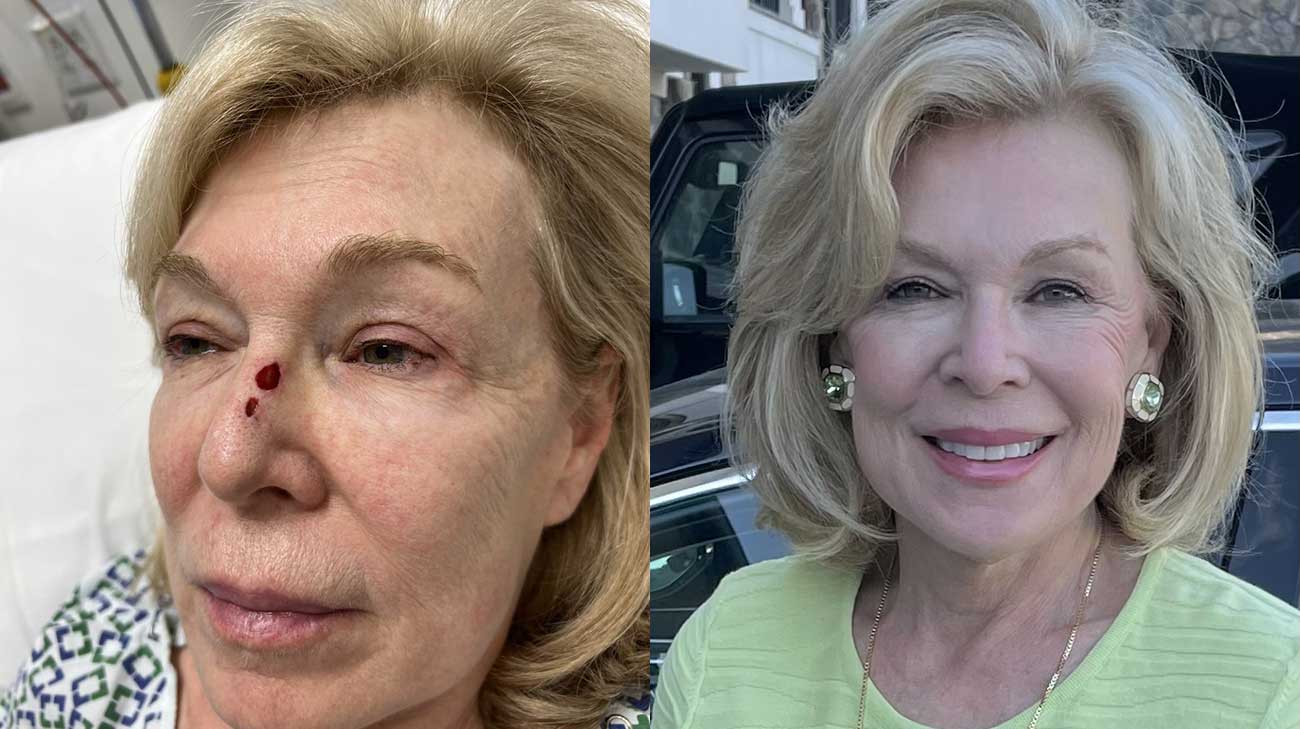
Anita Stapleton had a feeling something was wrong when she had a spot that kept growing back on her nose. Over a few years’ time, her dermatologist froze the growths off, and she finally convinced him to do a biopsy. It came back positive for skin cancer. In fact, it was the more serious squamous cell carcinoma, which spreads faster than the more common basal cell cancer.
“Your face is how you meet the world,” says Anita, “and I was terrified that removal would be disfiguring.” For a better understanding of the amount of cancer on her nose, Anita went to a Mohs surgeon in suburban Baltimore where she lives. The surgeon found an additional spot of squamous cell skin cancer.
Anita immediately contacted facial plastic and reconstructive surgeon Patrick Byrne, MD, MBA, Chairman of the Head & Neck Institute at Cleveland Clinic. Dr. Byrne had removed a lesion from her cheek 11 years earlier when he was practicing in Baltimore. He found the cancer when Anita went to him for a cosmetic consult, and he removed it while performing an eyelid lift for her (blepharoplasty).
Anita knew that she again wanted Dr. Byrne for her care, and she was determined to make the six-hour drive to Cleveland Clinic. Via electronic medical record, she provided Dr. Byrne with photographs and her biopsy reports. From Cleveland, Dr. Byrne and the team in the Center for Facial Reconstruction and Facial Nerve Disorders coordinated her care.
In August 2022, Anita traveled to Cleveland Clinic. Allison Vidimos, MD, Chair of the Department of Dermatology and Vice Chair of the Dermatology and Plastic Surgery Institute, performed the Mohs procedure to remove the cancer from both sides of her nose. Mohs involves removing progressive amounts of the skin to excise the cancer and biopsying each layer until the cancer is fully removed.
“I was scared, but I knew I was in extremely capable hands.”
Three days later, Dr. Byrne performed Anita’s nose reconstruction surgery, which involved a “local flap” procedure whereby the nose skin is rearranged to close the defect and keep the overall shape and contours as attractive as possible. Anita was able to have both procedures as an outpatient.
“Anita’s two areas of skin cancer covered a little more surface area than anticipated, but thankfully it was contained,” says Dr. Byrne. The nose, he explains, is the most complicated structure on the face to reconstruct because it is delicately shaped and three dimensional and the skin tissue is so limited.
“Your nose is the most prominent facial feature, and care must be taken to ensure that the repair does not twist the tip of the nose and leave a patient with a bad deformity,” he says. “The margin for error is small. You have to use the natural shadows — or zones of transition — to hide the incision lines so that people won’t notice them.”
“I was scared, but I knew I was in extremely capable hands,” says Anita. “I kept telling myself ‘it will be the best it that it can be.’” And it was. A week after the surgery, Anita had her stiches removed, and within 10 days, she was out in public again. “It’s a masterpiece,” she declares, showing before and after photos. “Even close friends said they didn’t notice the reconstruction within weeks of the procedures.”

Anita: Before (left) After (right)
She also says that she and her husband, Charles, were amazed by the “organization, expediency and professionalism” of Cleveland Clinic. Having worked in the medical device industry earlier in her career, Anita says that had not always been her experience with healthcare.
Dr. Byrne notes that the team of surgeons in the Center for Facial Reconstruction and Facial Nerve Disorders are “hyperspecialized,” only doing facial surgery. “We believe this is a real advantage, especially with nasal surgeries, which are the most common and complex,” he says. “Focus and experience make a difference. We have a wonderful team, and it’s great to see Anita healing so well.”
Related Institutes: Head & Neck Institute, Dermatology & Plastic Surgery InstitutePatient Stories
Perseverance and Focus Help Ovarian Cancer Survivor Beat the Odds HIPEC During Surgery Helps Keep Disease Under Control
Dec 10, 2025
Boy With Advanced Liver Cancer Thriving After Lifesaving Living Organ Donation From Aunt
Dec 8, 2025
Against All Odds A Journey of Recovery After Stroke
Dec 5, 2025
“Dr. Pervez is absolutely incredible, I can’t say enough about him and the speech therapy department. And Cleveland Clinic is phenomenal. They’ve always been wonderful, and I recommend them to everyone I talk to.”


